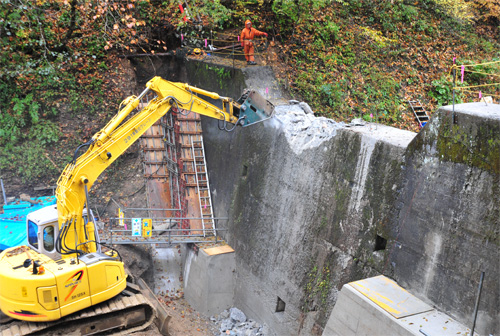
from Gunma, Japan vol. 50 2010.03.09 Making a very unusual decision to destroy a dam ~ Akaya Project
At the erosion control dam found within the approximately 10,000 hectare state-owned forest, located in the Minakami town in Gunma prefecture, a very unusual challenge that completely reverses common practice - that is intentionally destroying a dam - is being undertaken. The walls of the erosion control dam protect lives and homes from disasters caused by heavy rainfall, but it robs the animals that live in the rivers and streams of free passage. Launched in 2004 by 3 parties - the Kanto Regional Forest Office, Forestry Agency; The Nature Conservation Society of Japan; and a group representing the local residents - the "Akaya Project" made a bold decision to destroy a dam. Much discussion went into making this decision, but with hopes of restoring biodiversity, an unparalleled project is beginning to be implemented.
目次へ移動 Near the hot springs
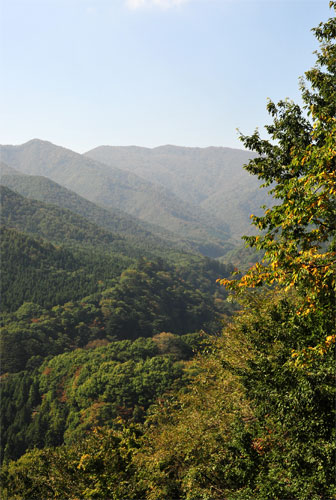 Photographed by: Tsunehide Chino
Photographed by: Tsunehide Chino
The state-owned "Akaya Forest" we visited this time is located in the town of Minakami, near the border of Niigata and Gunma prefectures. The nearest station to the town, the Jomo-Kogen station, is an hour and a half away on the bullet train from Tokyo. It takes about the same amount of time on a car via the Kan-etsu Expressway, so it is fairly easily accessible from the city. There are many hot springs with a great atmosphere along the way such as the Yujyuku Onsen, Sarugakyo Onsen, Kawafuru Onsen, and Houshi Onsen, so perhaps people who love hot springs have been in the area before.
Near such areas popular among tourists, there are very advanced activities underway that aim to bring back biodiversity. Have you heard about this project?
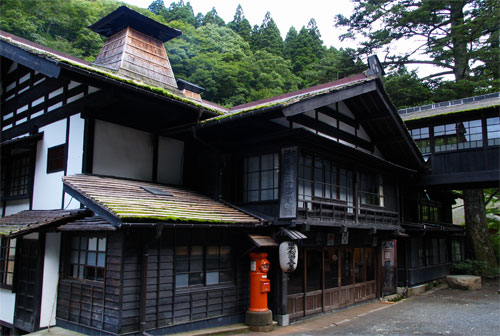 Generally speaking, the water that comes out as hot springs is water from rain or snow from 30-40 years ago that has been accumulated and heated underground. And it is the fruit of a very rich forest (Houshi Onsen, Choujukan).
Photographed by: Tsunehide Chino
Generally speaking, the water that comes out as hot springs is water from rain or snow from 30-40 years ago that has been accumulated and heated underground. And it is the fruit of a very rich forest (Houshi Onsen, Choujukan).
Photographed by: Tsunehide Chino
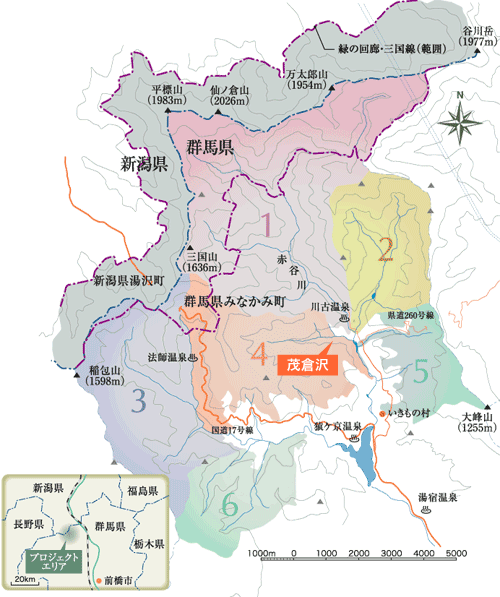 The Akaya Project Map
The Akaya Project Map
The Akaya forest, which has various visages, is subdivided into 6 broad categories. And the management theme has been tweaked to suit each area.
- Akaya headstream area - to restore natural forests with giant trees to protect the golden eagles' nest building site.
- Oizumata area - to protect the vegetation. Site for research and development of text for environmental education and implementation.
- Houshizawa/Mutakozawa area - to nurture forests where headsprings may be found and to protect the mountain hawk-eagle's nest building site.
- Old Mikuni-kaidou (road) area - to create forests that will help transform the old road into an optimal nature observation route and to restore the river/stream environment.
- Hotokeiwa area - to research ways in which forests may be used for traditional cultures such as creating charcoal and making tools, to support people's lives, and to communicate technologies.
- Kassedani area - to conduct research and implement experiential ways to manage man-made forests in a new era.
Shigekurasawa, where the dam destruction project I reported on is underway, is located in area 4. And the mountain stream restoration working group of the Akaya Project is in charge of the region.
目次へ移動 Seeing and experiencing what it's like onsite
November 10, 2009 - I took part in a site inspection and went to see the dam in question. Until now, countless concrete dams have been constructed in the middle of nature, but I took part in this inspection because I wanted to take a closer look at the historical site where a dam was "destroyed" for the first time in Japan through a public-works project.
The dam, which was destroyed, is the Shigekurasawa No.2 dam located on a tributary of the Akaya River, a reservoir along the Tone River. It is the second dam when you count from downstream.
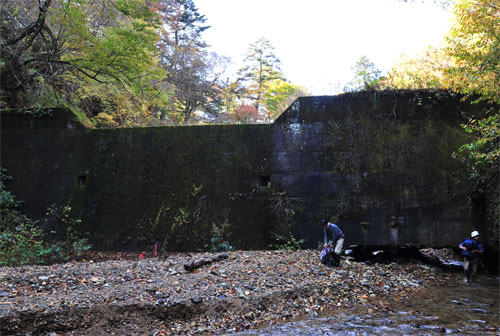 No.2 dam before construction
No.2 dam before construction
 The deconstruction began last year in October 26, and the central portion measuring approximately 8.6m of a dam 28m wide and 9m tall was taken down.
Photographed by: Tsunehide Chino
The deconstruction began last year in October 26, and the central portion measuring approximately 8.6m of a dam 28m wide and 9m tall was taken down.
Photographed by: Tsunehide Chino
From around 1945 to 1955, 17 erosion control dams were constructed on the river and tributaries in Shigekurasawa. This dam construction frenzy was a reaction to typhoon Kathleen, which hit Japan in 1947. The typhoon killed a total of 1,000 people; 592 died in Gunma prefecture. This tragedy caused by severe mudslides is still talked about even though it happened more than 60 years ago. Back then, there were hardly any trees on the mountains due to lack of resources during and after the war, which ended up magnifying the damage, and there was also a big cave-in in the Shigekurasawa area upstream. The construction of the Yamba Dam also began as a result of typhoon Kathleen.
目次へ移動 What kind of dam is an erosion control dam??
Although we referred to all dams as just being dams, there are actually many different types of dams. Some of the main dams include "flood control dams" that adjust water levels to prevent floods, "water utilization dams" that are used to secure water and for power generation, a "multi-purpose dams" that serves a combination of these functions, and "check dams" that prevent soil erosion and mudslides.
The dam that was taken down this time was an erosion control dam. Many of you may be hearing about this type of dam for the first time, but these dams are built in compliance with the "Forest Act" passed to protect and manage forests on rivers and streams where mountainsides are in danger of collapsing after heavy rains. It is hoped that this type of dam would yield the following 3 results:
- Stop soil erosion.
- Make slopes more gradual to slow down the speed of mudslides should they occur.
- Anchor the foot of the mountain (technical term for this part of the mountain is "spur").
The objective of an erosion control dam, simply put, is to "fix the mountain," so once the forest recovers, it has fulfilled its mission. Erosion control dams all around Japan have become damaged and deteriorated, but this is the first time that an erosion control dam has been intentionally taken down. On the other hand, even today, there are many dams around the country that are still mid construction.
Because erosion control dams are constructed on a remote river or stream deep inside the mountains, often times they don't involve payment of any relocation compensation. These dams serve as large sandbags in time of disaster, so the scales of these dams tend to be smaller. They are relatively easy to construct as a disaster prevention measure, so it is said that more erosion control dams have been constructed across Japan than was actually necessary.These dams badly damage the river/stream environment, but there have not been many opportunities to openly discuss their demerits.
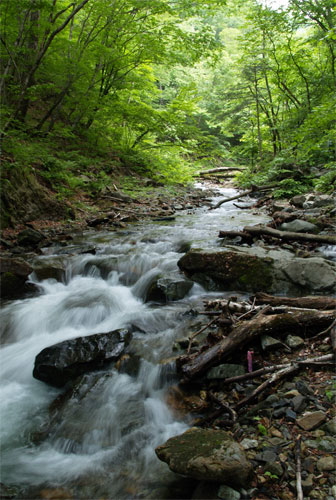 For nature, rivers are like our blood. By flowing smoothly, they encourage the "metabolism" of the river/stream environment. Photographed by: Tsunehide Chino
For nature, rivers are like our blood. By flowing smoothly, they encourage the "metabolism" of the river/stream environment. Photographed by: Tsunehide Chino
目次へ移動 The turning point, Erosion Control Project
As we mentioned before, The Nature Conservation Society of Japan (NACS-J) is one of the organizations that are responsible for the Akaya Project. In the feature article, "Restoration of the river/stream environment" published in its newsletter, "Nature Conservation," (March, April 2008 edition), Mr. Goichiro Takahashi, an associate professor of Environmental Systems Engineering, Toyama Prefectural University, wrote the following.
In places where disaster prevention measures have become no longer necessary or conditions have changed, we can reconsider plans to construct a concrete dam. And when reexamining the dam (for reparations or refurbishment) we can also have a think about making the dams smaller or removing them altogether. But in reality, such actions have never been undertaken (translation of excerpt).
Associate professor, Mr. Takahashi points out that "erosion control" - with traditional erosion control dams at the center - are facing a turning point since society's thinking and the law (※) is beginning to change with the times.
※ Respective laws include the Third National Biodiversity Strategy of Japan (drafted in 2007) and the Law for the Promotion of Nature Restoration, which attempts to restore lost natural environments (enacted in 2003). Moreover, the "Integrated Management of Sediment" illustrates how the policies on sediment management should undergo change with a new word, "sand-flow," to prevent the erosion of river channels and coasts caused by the lack of sediment being carried down from the mountains to the sea. These are all indications of how society has begun to focus on how to allow sediment to flow rather than to cut off sediment flow with traditional dams.
目次へ移動 Walking along the river and a trail lined with pebbles
Because we had to cross mountain streams, with sneakers my feet would get wet, so I borrowed a pair of boots with spikes and quickly headed down the road strewn with fallen leaves.
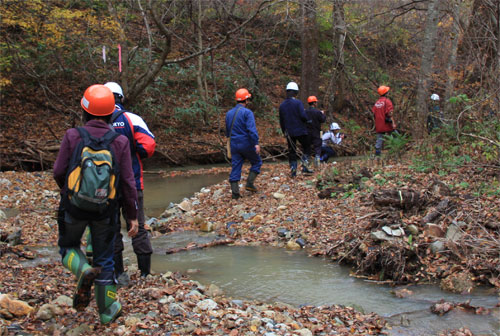 Laboriously walking down the path putting one foot in front of the other.
Laboriously walking down the path putting one foot in front of the other.
Everyone involved in the project that took part in the inspection said, "The forest has changed quite a bit when you compare its state to what it was 50 years ago." After half a century, the mountains have begun to regain its rich nature.
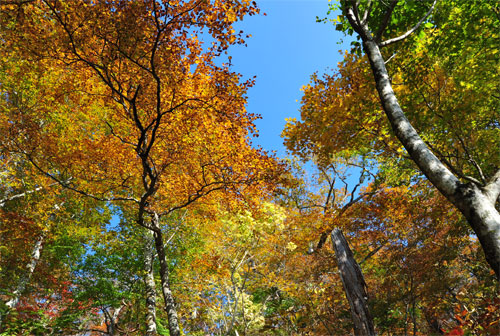 Photographed by: Tsunehide Chino
Photographed by: Tsunehide Chino
We arrived at the still-intact No. 1 dam, which is farther downstream than the No. 2 dam. The green moss that covers the concrete is an indication of the dam's long history. The water from the stream fell gently.
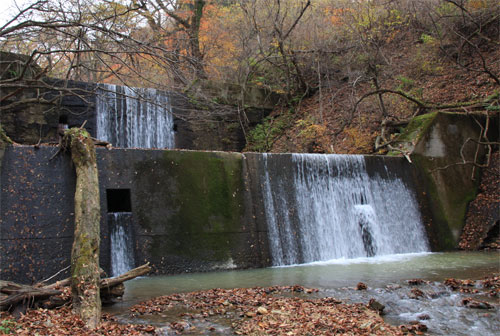 The No. 1 dam is the same size as the No. 2 dam and was built around the same time.
The No. 1 dam is the same size as the No. 2 dam and was built around the same time.
The bottom of the No. 2 dam fell apart in a flood 8 years ago, sending sediment downstream. That is why there wasn't very much water in the river on the way to the No. 2 dam. A rocky, pebbly path continues for a few hundred meters (sediment path).
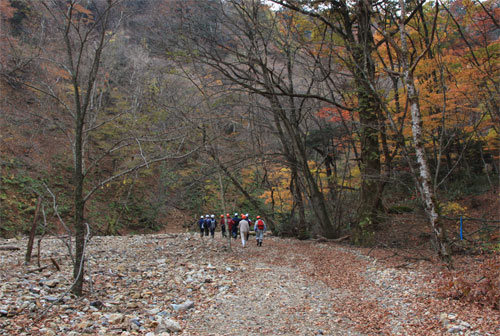 A long sediment path. The river flows down the edge.
A long sediment path. The river flows down the edge.
We finally arrived at the site where the No. 2 dam used to be.
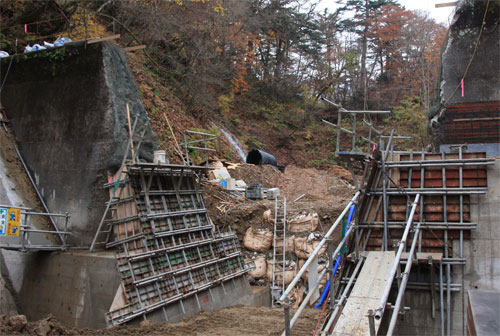 The remains of where the breaker took down the dam.
The remains of where the breaker took down the dam.
When we saw the remains of the dam, there was a few meters of sediment left at the bottom, and water was guided through pipes to go around the right side rather than the center of the dam where the bottom had fallen apart (construction completed by end of November).
Usually they create a path to let heavy machinery through, but for this construction, a small monorail was set up to bring necessary materials to the site. The construction was pushed back because they had found a Mountain Hawk-Eagle's nest, and the monorail was built to leave the environment in tact as much as possible.
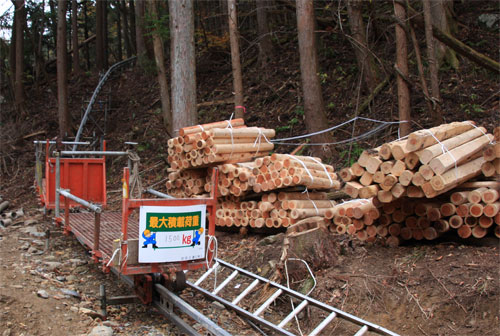 A mini monorail that delivers materials.
A mini monorail that delivers materials.
There were many questions from the people who took part in the inspection about the reason why both sides of the dam have been left in place. Some were quite harsh and asked, "People may not consider this as being dismantled." Of course it would be ideal if the whole dam could be taken down, but after taking the risks of excessive outpour of sediment or the collapse of the mountainside into consideration, as the initial step only the central part of the dam has been taken apart.
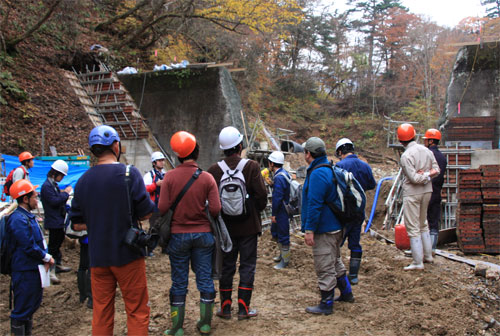 Many participants gathered in front of the dismantled dam
Many participants gathered in front of the dismantled dam
Examples of "slit dams" with comb-like slits or fish ladders allowing migration of animals and fish or facilitating the swim upstream for salmons during spawning season are found nationwide, but such a bold attempt to remove the dam, even its foundation, was never before undertaken in Japan.
Mr. Tsunehide Chino, a NACS-J staff who has been engaged in the project for a long time responded, "Whether or not the bottom structure barricades and impounds water is the criterion for determining whether or not the structure is considered a dam. In this case, the structure is no longer a dam since we have taken down the concrete entirely from its foundation." If even the slightest part of the foundation remains, this would affect the habitat of insects flying right above the water's surface.
"Rivers should be created by rivers." 、Mr. Chino's words left a lasting impression. removing a dam will allow the water and sediment to flow freely and the river will regain the power to create its own flow.This is the primary goal of removing the dam.
目次へ移動 Striking the difficult balance between biodiversity and disaster prevention
After visiting the No.2 dam, we went back again to a point halfway between the No.1 and No.2 dams, where "protection walls" have been newly constructed as a measure to control the outpour of sediment or water in case of floods.
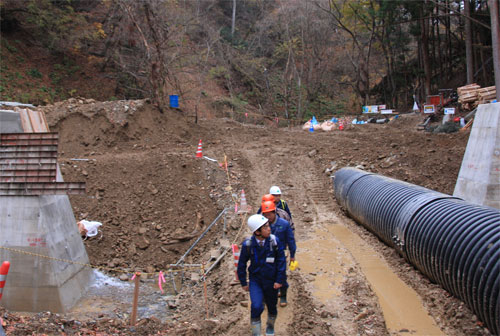 The concrete walls found on both sides are the protection walls. These walls have been erected between the No.2 and No.1 dams.
The concrete walls found on both sides are the protection walls. These walls have been erected between the No.2 and No.1 dams.
Low, concrete walls have been built like gates on both sides leaving a space about 11m wide in between. The protection walls have been constructed to prevent massive landslides in case mudslides occur as a result of heavy rainfall. They will continue to monitor the area over time and these walls will be "removed" once they are confident that the mountain may be safely preserved without these walls.
The mountain stream restoration working group was established within the Akaya Project in 2005. And at that time, a partnership with an organization of experts, the "research committee for the master plan for the Shigekurasawa Erosion Control Project in the area of Niiharu (Chairman: Mr. Takehiko Ohta, professor emeritus at Tokyo University)," was also created. Support from such an organization has also backed the reasoning for dam destruction since inspection by and knowledge of specialists are essential to verifying disaster-prevention measures.
The project finally received the green light when the following criteria were met: the forest had significantly recovered, there are no homes in the surrounding area that may be affected should mudslides occur, and since the No.1 dam is located downstream, it can prevent disasters, so technological development related to the dam destruction may be implemented further upstream. The aim of the project is to restore the river/stream environment and thereby bring back biodiversity, but it is clear that it is very difficult to strike a balance between restoring biodiversity and preventing disasters.
目次へ移動 New way to make decisions
Some people may consider the partial destruction of the erosion control dam as a "small step." But this project intentionally destroyed a concrete structure, which in the past were only constructed (never destroyed) in the middle of nature, by also involving the government. This means that the project will be financed by national tax, but the fact that the decision was made based on a consensus reached through discussions with local people was an enormously big step.
So, how was such a decision-making platform created?
目次へ移動 A coincidental beginning
The Akaya Project is officially called the "Biodiversity Restoration Program for the Mikuni Mountains and Akaya River." This project, which has rather a long name, is based on the agreement signed by the Kanto Regional Forest Office, Forestry Agency, NACS-J, and the Akaya Project local council on March 30, 2004.
What had created the foundation for this project were the protest movements undertaken by the local residents against construction plans for ski resorts and dams, which emerged during the bubble years. I was told that the region's relationship with NACS-J began back then. It became apparent through these movements that forests not only provide delicious water and rich hot springs, but they are also home to endangered species such as golden eagles, Mountain Hawk-Eagles, Asian Black Bears and Japanese Serows.
 (Upper left) Asian Black Bear, (upper right) Mountain Hawk-Eagle, (lower left) Japanese Serow, (lower right) family of golden eagles - illustration by Ms. Misako Hirata, Forest Officer of the Forestry Agency who was in charge of the Akaya Forest from 2005-2007
(Upper left) Asian Black Bear, (upper right) Mountain Hawk-Eagle, (lower left) Japanese Serow, (lower right) family of golden eagles - illustration by Ms. Misako Hirata, Forest Officer of the Forestry Agency who was in charge of the Akaya Forest from 2005-2007
In 2000, affected by the collapse of the bubble economy, development plans for ski resorts and dams were called off. Although the residents were successful in preserving nature, they did not consider it as "the end," rather they began to feel a desire to put into place a system that further preserves and nurtures nature. The NACS-J, on the other hand, was searching for a suitable location for a model case to demonstrate the process involved in restoring biodiversity for a case involving a difficult evaluation method. The interests of the 2 parties overlapped nicely, and they decided to approach the Forestry Agency with a proposal to jointly manage the state-owned Akaya Forests.
The response of the Kanto Regional Forest Office, Forestry Agency, to the proposal was better than what they had expected and the preparatory meeting was set up smoothly. The national government had lead the management of state-owned forests until then, but it was decided that any decisions regarding the Akaya Forest would require the approval of the "project management meeting" involving the members of the local council and NACS-J. Although legally, the manager of the forest is the Kanto Regional Forest Office, the authorities promised in the agreement that they will reflect the matters discussed with the Akaya Project in their program.
What lies behind the Forest Agency bestirring itself to take such an unprecedented, concerted step are the changes of the times with respect to state-owned forests. The prices of timber produced since the end of the war declined dramatically in the 1970s. And the Forest and Forestry Basic Act was revised in 2001 when the government saw that traditional policies that focused on the cultivation of man-made forests was reaching the end of the line. In this act, the government decided that it would focus more on the innate ability of the forest to, for example, protect water and soil, coexist with mankind, and ability to maintain a good cycle that provides a sustainable supply of natural resources.
Some newspapers reported that the Forestry Agency and NACS-J had reached a "historical reconciliation" since the 2 parties had clashed over logging of state-owned forests in the past. Mr. Naoya Tanaka, director of the Akaya Forest environmental preservation fureai (interaction) center, Kanto Regional Forest Office, recalls, "I had also witnessed the local people protesting against the Kawafuru Dam construction (planned by the Ministry of Land, Infrastructure, Transport and Tourism), so there was a growing momentum to work together for the future of forests."
目次へ移動 The voices of many people concerned about the forest
The Akaya Project is comprised of members of the core organizations and approximately 50 to 60 volunteers in the Kanto region who are recognizable by the matching hats. In the Akaya forest, there is a work shed, which was used in the past to grow seedlings for man-made forests, and this is now called "Ikimonomura (living creature's village)" and is used as a base for the project's activities. Volunteers gather here on "Akaya day," which takes place every first weekend of the month to carry out various activities such as research on living organisms that inhabit the forest, communicating with the local people, as well as traditional charcoal making. The voices of many people concerned about the forest are helping to further enrich the project.
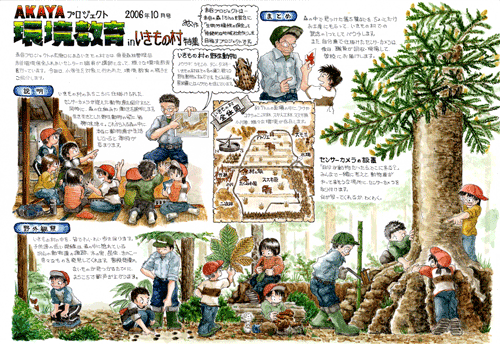 The illustration by Ms. Hirata depicts how the children of the local elementary school, Sarugakyo Elementary School, learn about nature while playing in the area near the "Ikimonomura."
The illustration by Ms. Hirata depicts how the children of the local elementary school, Sarugakyo Elementary School, learn about nature while playing in the area near the "Ikimonomura."
"The processes of coming up with ideas for a new system, attitudes for getting involved, how to get a consensus, or knowing what we should think about when a problem occurs so that we really do end up thinking about the core issue; these processes themselves serve as a model case" says Mr. Chino.
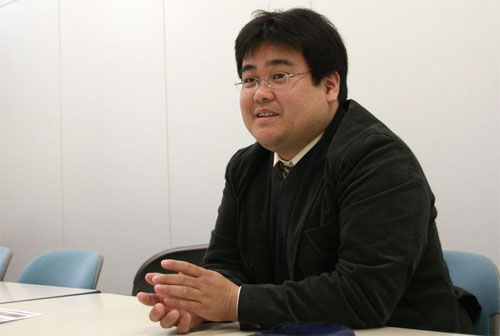 Mr. Chino of NACS-J
Mr. Chino of NACS-J
Because removal of an erosion control dam is unprecedented, there is no established evaluation technology. In addition, there are no decision criteria for biodiversity either, so they will continue to carefully monitor and collect data of endangered species, conditions of the forest and sediment along the river as well as insects and fishes. Everyone involved in the project share the hope that one day they will be able to say, "That was a significant step" in 5 to 10 years from now. The members aspire to establish the Akaya Project as a model case for management of the erosion control/check dams around Japan that have become decrepit over time and require renovation.
目次へ移動 Taking hints from the relationship between man and forest
Ms. Yasuko Mochitani , the okami (female maitre d'hotel of ryokans ) of the Sarugakyo Hotel and a leading storiologist from the village formerly known as Niiharu (currently the town of Minakami), shared a story she heard from a local elderly woman born in the Meiji Era.
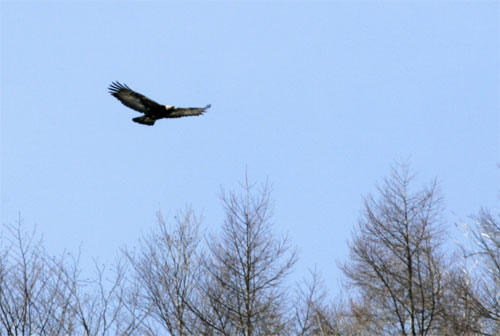 A golden eagle flying over the forest
Photographed by:
Jyo Takano
A golden eagle flying over the forest
Photographed by:
Jyo Takano
One day in May during rice-planting season, a young mother made lunch and headed towards the rice fields. She left her baby by the edge of the rice field and began to plant. She kept checking on the baby while she planted the rice seedlings, but she became engrossed in her work and took her eyes off her baby. Just at that instance, a huge eagle swooped down and swept the baby away.
"Oragakakko (My baby)!!" The young mother hurried after the eagle with her muddy feet but she couldn't find her baby. The young mother continued to cry out "Oragakakko" as she looked for her baby, and at last she turned into a cuckoo (in Japanese "kakko" means a cuckoo).
Ms. Mochitani says, "Cuckoos actually come to the rice fields in May even today. They fly very low over the fields as if they are looking for something." The muddy feet of the mother searching for her lost child come from cuckoos' marbled colored feet. Though it is not explicitly stated whether the eagle that took the baby away was a golden eagle or not, the story depicts how people perceived the big eagle in their daily lives and you can even picture what life must have been like back then.
For example, Mr. Chino says,"Thinking about what golden eagles mean for the people in the region ultimately leads to power that will help protect the region." I was impressed by how carefully they study and respect the relationship between the local people and the forest.
The task in the future is to realize the hope of the local people to "restore the forest to its original state." The local council thinks that they "only represent a small group of people in the region" since the town is not proactively involved in the project yet. This is just the beginning.
目次へ移動 Instead of a conclusion - timeline for disaster prevention
Taking part in the inspection, I came to realize how difficult it is to "communicate" what it means to remove a dam. It takes time before we can see tangible effects of restoring biodiversity, and such "effects" are not necessarily beneficial for us humans in a way that we can easily understand. I felt that it is difficult to give a clear overview of the project with immediacy, for example, such as publishing it in tomorrow's paper.
Dams were constructed in places from where the forest has disappeared
→ Then, the forest was restored over a long period of time
→ Dams have become no longer necessary.
The removal of the dam was determined based on such a long timeline, but I thought this sequence is very important. It made me realize how we don't normally look at "disaster prevention" measures with such a long time-span in mind. In other words, we don't usually come up with sustainable "disaster prevention" measures after carefully thinking about the relationship between man and forest.
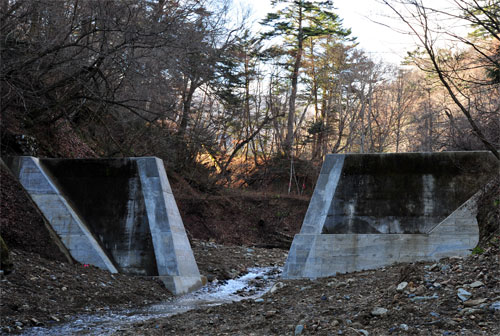 No.2 dam after removal is completed.
Photographed by: Tsunehide Chino
No.2 dam after removal is completed.
Photographed by: Tsunehide Chino
Mr. Chino told us that "it's impossible to set a goal for the Akaya Project." Everyone involved in the project estimates that it would take a longer time than their own lifetime to restore the forests and biodiversity to the original state. I thought that understanding and sharing such timeline is the first step. I also began to think that we should listen to what nature is trying to tell us over and over again, and build consensus carefully based on what we learn from nature, and although it may be frustrating at times, making such on-going efforts is what lies at the heart of the mission of the pilot program, Akaya Project.
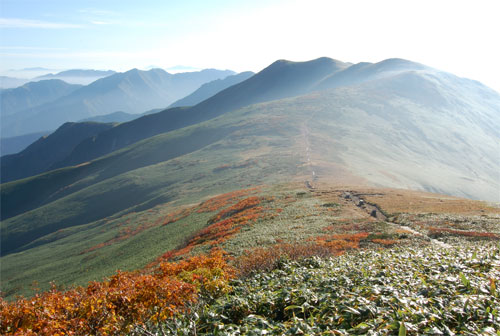 Photographed by: Seiichi Dejima
Photographed by: Seiichi Dejima
Links
NACS-J - THE NATURE CONSERVATION SOCIETY OF JAPAN
Akaya Project
Mitsuko Iwai Biography
She has worked for a local museum/news paper publisher before she became a freelance writer. In 2002, she became involved in publishing a book of record of government's cultural programs and became intrigued with the ideas and lifestyles in the various regions that are passed down from one generation to the next. In 2004, she published the first issue of "Satomi Tsushin" which focuses on the theme, fixed-point observation of farms and farmers. She is also an as an editorial staff for the Earth News for the Think the Earth Project. She currently lives in Takasaki.
Reported and orginal Japanese text written by: Mitsuko Iwai
Translated by: Yuri Morikawa (oxygen inc.)
photographs by: Takuji Sasaki (Think the Earth Project)
Photographs provided by/Cooperation from: The Nature Conservation Society of Japan (NACS-J)















